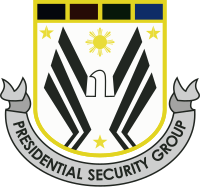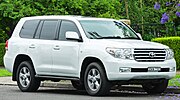| This article needs additional citations for verification. Please help improve this article by adding citations to reliable sources. Unsourced material may be challenged and removed. Find sources: "Presidential Security Command" – news · newspapers · books · scholar · JSTOR (May 2008) (Learn how and when to remove this message) |
| Presidential Security Command | |
|---|---|
 Coat of Arms of the PSG Coat of Arms of the PSG | |
| Active | June 23, 1898 – present |
| Country | |
| Branch | Army, Navy, Air Force, Marines, Coast Guard, and Police. |
| Role |
|
| Size | 1 Brigade/Regiment, 3 Battalions. Total is 4000+ soldiers, police, coast guard and civilian personnel |
| Part of | Armed Forces of the Philippines |
| Garrison/HQ | Malacañang Park, Malacañang Palace, Manila |
| Nickname(s) | PSC, The President's Guards, Presidential Guards, Filipino Secret Service, Men in Barong, PSG Troopers |
| Motto(s) | Integrity, Service, Excellence |
| Mascot(s) | Eagle |
| Anniversaries | June 23 |
| Decorations | Presidential Streamer Award, Philippine Republic Presidential Unit Citation Badge |
| Website | http://psgtroopers.com/2017/ |
| Commanders | |
| Current commander | MGen. Jesus Nelson B. Morales, PAF |
| Notable commanders |
|
| Insignia | |
| Unit Patch | PSG Badge |

The Presidential Security Command, (PSC) formerly known as Presidential Security Group (PSG), is a Philippine close protection agency. It is the primary agency concerned with providing close-in security and escort to the President of the Philippines, their immediate families, former presidents of the Philippines as well as visiting heads of state.
The PSC is stationed at Malacañang Palace, the official residence of the president. Members of the PSC also accompany the president on both domestic and overseas trips.
History
While the present-day force was established in 1987, the protection of the president and the presidential family has always been the duty of the Armed Forces of the Philippines since 1897.
On June 23, 1898, a guards unit called as the Cuerpo de la Guardia Presidencial (Presidential Guard Corps) was raised at the time to protect the first official president, Emilio Aguinaldo, from attempts on his life. Composed of a presidential cavalry squadron and artillery batteries, reinforced with multiple guards infantry battalions all under the command of Major Geronimo Gatmaitan, which provided the protection of President Aguinaldo and his family. Like today's PSC, they wore rayadillo uniforms, but with straw hats.
In 1936, the 1st Cavalry Regiment of the 1st Infantry Division, Philippine Army, raised the same year, was tasked with defending President Manuel Quezon, his family, and the palace complex. On May 22, 1938, they were joined by the Malacanang Guards, made up of a company organized into two to three platoons with a little over a hundred members, to reinforce the President's security.
During the Second World War, the Presidential Guards were combined with the Philippine Constabulary and Manila ROTC units to form the new Second Regular Division which fought in Bataan. After the inauguration of the Second Philippine Republic, units of the occupying Imperial Japanese Army initially took over guard duties at the palace, only to be replaced by an all-Filipino guard battalion at the insistence of President José P. Laurel. During the Battle of Manila in 1945, Presidential Guardsmen remained at their posts in Malacañang. At war's end, it was in turn replaced by the AFP Presidential Guards Battalion under the orders of President Sergio Osmeña and would remain until the time of his successor, Manuel Roxas.
The PSG of today traces its origins to 1950 when President Elpidio Quirino transferred the Presidential Guards Battalion under the control of the Philippine Constabulary (PC) in 1950. At the same time, a separate presidential security unit was founded as the secret service and protective unit of the state presidency, the First Family, and Malacañang Palace, under the control of the Constabulary (first the Secret Service of Malacañang Palace then later renamed into the Presidential Security Force, the Presidential Security Unit, and then the Presidential Security Agency). On October 22, 1971, under the Presidency of Ferdinand Marcos, General Order No. 212 GHQ, AFP was issued, creating the Presidential Security Command (PSC) as a unified command of the AFP.
When President Corazon Aquino was sworn in as president, she gave the order to disband the PSC and replace with "a leaner" Presidential Security Group (PSG), with then-Army Colonel (and future Secretary of National Defense) Voltaire Gazmin as its chief. This was formalized by General Order No. 60, GHQ-New Armed Forces of the Philippines (NAFP), which deactivated the PSC and activated the PSG as one of the support units of the NAFP. The PSG, then as in the present, has always included both civilian agents and seconded servicemen from the Armed Forces.
The PSG launched the PSG Troopers website on February 10, 2017, as part of an effort to improve public relations. Information concerning the president's security arrangements are considered as classified.
Four PSG officers were wounded in an encounter with New People's Army guerillas in Arakan, North Cotabato after they were spotted running a fake vehicle checkpoint.
On September 26, 2017, a PSG officer was found dead inside the Malacañang complex with a gunshot wound to the chest.
In January 2024, the Department of National Defense officially disclosed that the Presidential Security Group (PSG) was expanded from a group to a command, now officially known again as the Presidential Security Command (PSC), restoring the setup of the organization during the time of President Ferdinand Marcos, late father and namesake of the current President, Bongbong Marcos. The term PSC was earlier utilized on January 19 when the agency's Commander, MGen. Nelson Morales, issued a statement reacting to criticisms on Marcos’ use of the presidential helicopter to travel to the Philippine Arena in Bulacan to watch the Coldplay concert.
In 2024, the Armed Forces of the Philippines (AFP) activated the Vice Presidential Security and Protection Group (VPSPG), which is a separate unit from the PSG for the security of Sara Duterte. In July 2024, VPSPG will be totally integrated with the Presidential Security Command after 75 personnel of the Police Security and Protection Group (PSPG) assigned to the VPSPG were transferred to the National Capital Region Police Office.
Role
The role of the PSC is tasked with:
- Providing security to:
- The president and their immediate family.
- The president-elect and their immediate family.
- The vice president and their immediate family.
- Visiting heads of states or diplomats and Cabinet members and their families travelling with them and other guests.
- Visitors of the Presidential Museum and Library.
- Providing escort security for them at all times.
- Securing the president residences, offices, and places of engagements.
- Surveillance and monitoring activities.
- Performing state protocol duties including honor guard duties.
- Crowd Control.
The Presidential Security Command also have other functions, such as providing support to other government agencies. They assist the AFP and PNP in its anti-organized-crime and corruption undertakings, usually authorized by the Office of the President. They also conduct community service efforts in local communities, and maintain and secure all facilities and transportation assets used by the offices of the president and vice president in doing its regular and non-regular functions.
Organization
The following are organized under the PSC (formerly the PSG) as of 2023:
Key personnel
- Commander
- Chief of Staff
- Special Reaction Unit Commander
- Commanding Officers
- Headquarters and Headquarters Service Battalion
- Security Battalion
- Presidential Escorts Battalion
- Presidential Guards Battalion
Units

- Headquarters & Headquarters Service Battalion
- Presidential Escorts - the actual personnel accompanying the President and his/her immediate family
- Guard Battalion
- Security Battalion
- Special Reaction Unit
- K9 Unit
- PSG Station Hospital
- PSG Dental Dispensary
- Presidential Intelligence Company
- PSG Training School
- PSG Band
Recruitment
Agents are usually personnel from the Armed Forces of the Philippines, Philippine National Police and Philippine Coast Guard. However, there are a few civilian personnel acting as support units.
Military and police personnel serving in the PSC retain the ranks and insignia of their parent service which are worn in almost all orders of dress.
Equipment
| This section needs additional citations for verification. Please help improve this article by adding citations to reliable sources in this section. Unsourced material may be challenged and removed. (August 2019) (Learn how and when to remove this message) |
PSC members are known to carry assorted firearms, some known firearms include:
-
 Glock pistols
Glock pistols
-
 M1911 pistol
M1911 pistol
-
 Heckler & Koch USP
Heckler & Koch USP
-
 Heckler & Koch MP5
Heckler & Koch MP5
-
 Heckler & Koch G36
Heckler & Koch G36
-
 Colt/Elisco M4A1 5.56mm Assault Rifle
Colt/Elisco M4A1 5.56mm Assault Rifle
-
Remington R4 5.56mm Carbine
-
 FN MAG
FN MAG
-
 Armbrust
Armbrust
-
 Mistral (missile)
Mistral (missile)
The PSC utilizes Motorola trunked two-way radios with encryption capability.
Vehicles
The PSC currently uses a fleet of vehicles, ranging from motorcycles; armored modified sedans and mid-sized vehicles; and armored personnel carriers.
-
 Honda Gold Wing
Honda Gold Wing
-
 Audi A6
Audi A6
-
 BMW 7 Series
BMW 7 Series
-
 Hyundai Equus
Hyundai Equus
-
 Toyota Camry
Toyota Camry
-
 Nissan Patrol
Nissan Patrol
-
 Toyota FJ Cruiser
Toyota FJ Cruiser
-
 Toyota Land Cruiser
Toyota Land Cruiser
-
An unmarked Toyota Fortuner with a lightbar siren mounted on top of the SUV
-
 Mitsubishi Montero Sport
Mitsubishi Montero Sport
-
 Hyundai Starex
Hyundai Starex
-
 Chevrolet Suburban
Chevrolet Suburban
-
 Ford E-250
Ford E-250
-
Philippine Army M113 armored personnel carrier
-
 Philippine Army AIFV
Philippine Army AIFV
-
Philippine Army Cadillac Gage Commando
Notes
References
- ^ Romero, Alexis (January 23, 2024). "President's security upgraded from group to command". gmanetwork.com.
- https://www.officialgazette.gov.ph/1987/03/01/speech-of-president-corazon-aquino-during-the-psg-anniversary/
- "Presidential Security Group - History". globalsecurity.org. n.d. Retrieved July 12, 2023.
- "Administrative Order No. 128, s. 1950". Official Gazette of the Republic of the Philippines.
- ^ "DND RLIP (TIS) - DBM Organization, Position Classification and Compensation Bureau" (PDF). dbm.gov.ph/. 2011. Retrieved July 22, 2024.
- "President Aquino leads Presidential Security Group's 29th anniversary celebration". March 10, 2015.
- ^ Ranada, Pia (February 10, 2017). "Presidential Security Group launches website". Rappler.
- Admin, PSG Troopers Website (July 19, 2017). "PSG encounters NPA at Arakan North Cotabato".
- Corrales, Nestor (September 26, 2017). "PSG officer found dead in Malacañang complex". newsinfo.inquirer.net.
- Casucian, Jiselle (January 20, 2024). "PSG: Marcos rode presidential chopper to Coldplay concert for his safety". gmanetwork.com.
- Regalado, Edith. "Sara stripped of 75 security personnel". Philstar.com. Retrieved July 26, 2024.
- ""PSG" (Documentary by Sandra Aguinaldo)". GMA News. January 7, 2011. Retrieved July 16, 2011.
- "FEATURE | Former PH presidents given 8 security personnel". Bicol Standard | Bicol News | Bicol Newspaper.
- "NGA" (PDF). www.coa.gov.ph. 2010. Retrieved November 4, 2019.
- Admin, PSG Troopers Website (July 5, 2018). "121 Years of Selfless Service and Dedication to Duty".
- "Develop Philippine arms industry, group urges". philstar.com.
- "Philippine Daily Inquirer - Google News Archive Search". news.google.com. Retrieved July 1, 2016.
External links
| Philippine Department of National Defense | |
|---|---|
| Executive departments of the Philippines | |
| Sub-agencies | |
| AFP Service Branches | |
| AFP Sub-branches | |
| AFP Reserve Units | |
| AFP Former Units and War-time attached Units | |
| Attached | |
| See also: list of Ministries of Defense by country | |
| Armed Forces of the Philippines (AFP) |
|
|---|---|
| Leadership | |
| Army | Reserve Command (RESCOM) |
| Air Force | |
| Navy | |
| Coast Guard | Coast Guard Auxiliary |
| Wars and conflicts | |